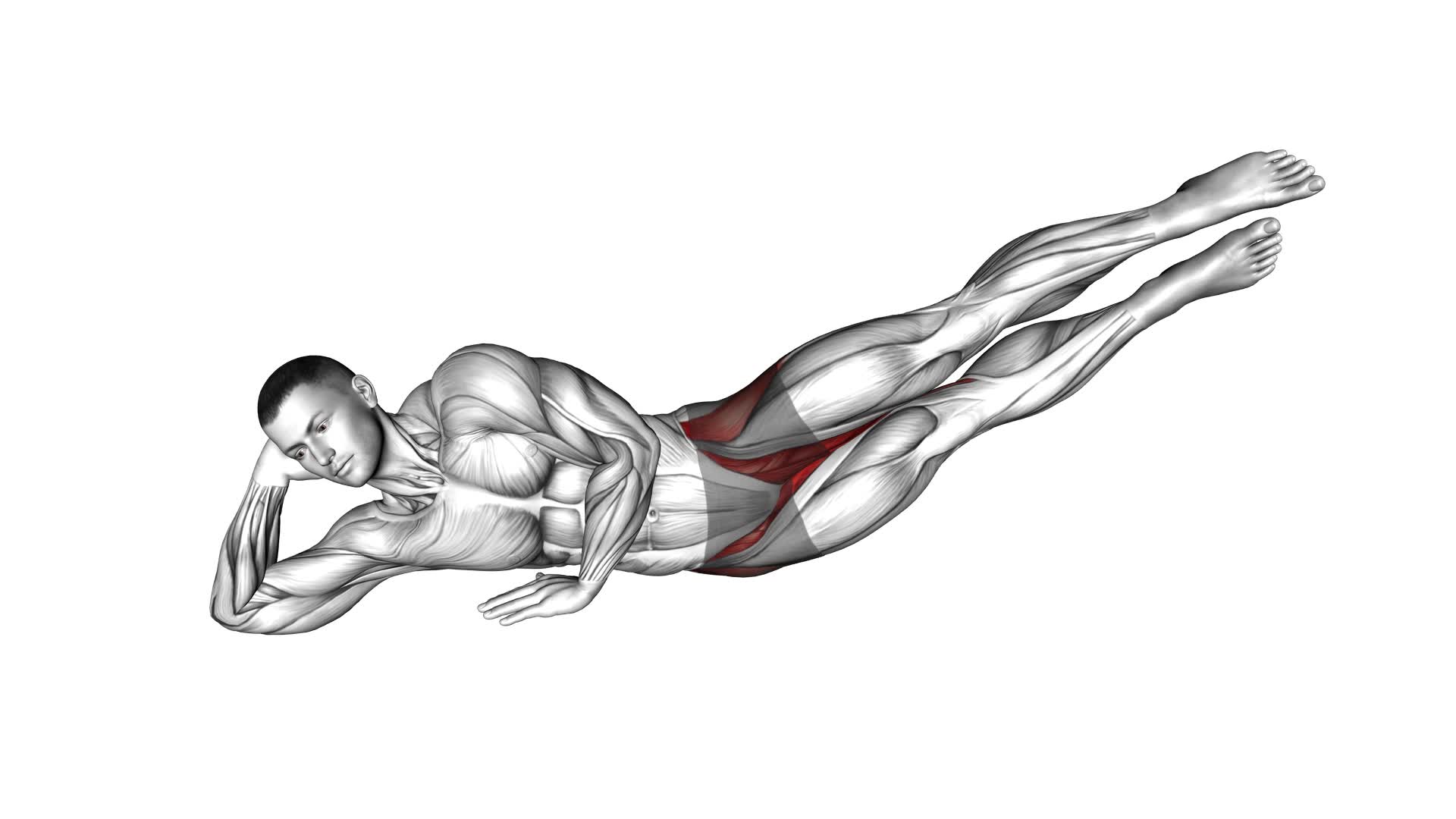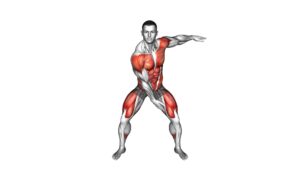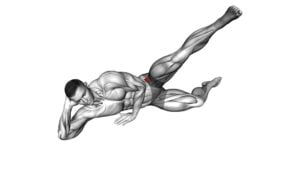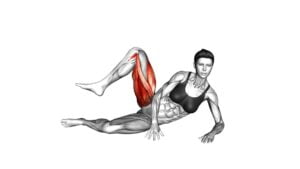Bodyweight Side Lying Inner Thigh-up and Down (male) – Video Exercise Guide & Tips

Get ready to tone and strengthen your inner thighs with the Bodyweight Side Lying Inner Thigh-up and Down exercise! In this video exercise guide, we'll show you the proper form and technique to maximize your results.
Watch This Exercise Video
No equipment needed – just your bodyweight! Whether you're a beginner or advanced, we have modifications for all fitness levels. Avoid common mistakes and get tips on how to incorporate this exercise into your fitness routine.
Let's get those inner thighs burning!
Key Takeaways
- The Bodyweight Side Lying Inner Thigh-up and Down exercise targets and strengthens the inner thigh muscles.
- It helps improve lower body strength and stability.
- This exercise can help tone and sculpt the inner thighs.
- It enhances hip mobility and flexibility.
Benefits of the Bodyweight Side Lying Inner Thigh-up and Down Exercise
Experience the numerous benefits of the Bodyweight Side Lying Inner Thigh-up and Down exercise. This exercise is a great way to target and strengthen the inner thigh muscles. By engaging these muscles, you can improve your overall lower body strength and stability.
One of the main benefits of this exercise is that it can help tone and sculpt your inner thighs. The side lying position allows for targeted activation of the inner thigh muscles, helping to slim down this area and create a more defined look. Additionally, this exercise can also help improve your hip mobility and flexibility.
Another great benefit of the Bodyweight Side Lying Inner Thigh-up and Down exercise is its versatility. There are several variations of this exercise that you can incorporate into your routine to keep things interesting and challenge your muscles in different ways. For example, you can add resistance bands or ankle weights to increase the intensity, or perform the exercise on an unstable surface like a balance board or foam pad to work on your balance and stability.
Proper Form and Technique for the Bodyweight Side Lying Inner Thigh-up and Down Exercise
To perform the Bodyweight Side Lying Inner Thigh-up and Down exercise correctly, follow these steps:
- Lie on your side with your legs extended straight out.
- Place your top leg in front of your bottom leg, with your foot resting on the ground.
- Keep your top leg straight and lift it up as high as you comfortably can, then lower it back down.
During this exercise, you may face some common challenges, such as maintaining proper form and control throughout the movement. It's important to focus on engaging your inner thigh muscles and avoiding any swinging or jerking motions. Additionally, you may experience difficulty in lifting your leg up high due to limited flexibility or strength. If this is the case, start with a smaller range of motion and gradually work your way up as you become more comfortable and stronger.
For those looking to target specific muscle groups, there are variations of the Bodyweight Side Lying Inner Thigh-up and Down exercise. To focus more on the glutes, you can add a resistance band around your thighs or use ankle weights. To target the outer thigh muscles, try lifting your leg out to the side instead of straight up and down.
Now that you have a clear understanding of the proper form and technique for the Bodyweight Side Lying Inner Thigh-up and Down exercise, let's move on to discussing modifications for different fitness levels.
Modifications for Different Fitness Levels in the Bodyweight Side Lying Inner Thigh-up and Down Exercise
As you progress in your fitness journey, there are modifications you can make to the Bodyweight Side Lying Inner Thigh-up and Down exercise to accommodate different fitness levels.
Whether you're a beginner looking for a gentler option or an advanced athlete seeking a greater challenge, there are progression options and equipment variations that can meet your needs.
For beginners or individuals with limited mobility, starting with a smaller range of motion can be helpful. Instead of lifting your leg all the way up and down, you can begin by lifting it only a few inches off the ground. This modification allows you to focus on engaging the inner thigh muscles without putting too much strain on your joints.
On the other hand, if you're looking to intensify the exercise, using resistance bands or ankle weights can provide an extra challenge. By adding external resistance, you increase the workload on your inner thighs, making the exercise more demanding and effective.
Additionally, if you have access to a stability ball, you can incorporate it into the exercise. Placing the stability ball between your thighs while performing the side lying leg lifts adds an element of instability, engaging your core muscles even more.
Common Mistakes to Avoid in the Bodyweight Side Lying Inner Thigh-up and Down Exercise
One common mistake to avoid in the Bodyweight Side Lying Inner Thigh-up and Down exercise is improper alignment. Maintaining proper alignment is crucial to ensure that you're targeting the correct muscles and avoiding any unnecessary strain or injury.
Here are some other common mistakes to watch out for:
- Allowing the top leg to rotate forward or backward: It's important to keep the top leg in a neutral position throughout the exercise. Rotating the leg can lead to improper muscle activation and diminish the effectiveness of the exercise.
- Relying on momentum: This exercise should be performed with control and precision. Avoid using momentum to swing your leg up and down. Instead, focus on engaging the inner thigh muscles and moving slowly and deliberately.
- Neglecting the core engagement: Your core plays a significant role in stabilizing your body during this exercise. Make sure to engage your core muscles by drawing your navel towards your spine and maintaining a strong and stable torso throughout the movement.
By avoiding these common mistakes and focusing on proper alignment, control, and core engagement, you can maximize the benefits of the Bodyweight Side Lying Inner Thigh-up and Down exercise.
Remember to listen to your body, make modifications for different fitness levels, and always consult with a qualified fitness professional if you have any concerns or questions.
Tips for Incorporating the Bodyweight Side Lying Inner Thigh-Up and Down Exercise Into Your Fitness Routine
You can easily incorporate the Bodyweight Side Lying Inner Thigh-Up and Down exercise into your fitness routine for a targeted inner thigh workout. Inner thigh exercises are important for strengthening and toning the muscles in this area, which can help improve overall lower body strength and stability. Adding variations of bodyweight exercises can help to keep your workouts interesting and challenge your muscles in different ways.
To incorporate the Bodyweight Side Lying Inner Thigh-Up and Down exercise into your routine, start by lying on your side with your legs extended and stacked on top of each other. Place your bottom arm on the floor for support and bend your top leg at the knee, placing your foot flat on the floor in front of your bottom leg. From this position, lift your bottom leg off the floor as high as you can, then slowly lower it back down. Repeat for the desired number of repetitions, then switch sides.
You can also try variations of this exercise by adding ankle weights or using a resistance band around your thighs to increase the intensity. Additionally, you can incorporate other inner thigh exercises, such as leg lifts or inner thigh squeezes, into your routine to target this area from different angles.
Remember to listen to your body and start with lighter weights or resistance bands if you're new to these exercises. As always, consult with a fitness professional before starting any new exercise program.
Frequently Asked Questions
How Long Should I Hold the Bodyweight Side Lying Inner Thigh-Up and Down Exercise?
To get the most out of the bodyweight side lying inner thigh-up and down exercise, it's important to know how long to hold it. The duration of the hold can vary depending on your fitness level and goals.
Generally, it's recommended to hold each repetition for 1-2 seconds before moving on to the next one. This helps engage the inner thigh muscles effectively.
However, if you have a knee injury, it's essential to modify the exercise or consult with a professional for appropriate modifications.
Can I Perform This Exercise if I Have a Knee Injury?
If you have a knee injury, it's important to be cautious with exercises that may aggravate it. Before attempting the bodyweight side lying inner thigh-up and down exercise, consult with a healthcare professional or physical therapist.
They can provide modifications or alternative exercises that target the inner thigh muscles without putting stress on your knee.
Always prioritize your safety and listen to your body's signals during workouts.
How Many Repetitions Should I Do for Each Set of the Bodyweight Side Lying Inner Thigh-Up and Down Exercise?
To determine the number of repetitions you should do for each set of the bodyweight side lying inner thigh-up and down exercise, consider your fitness level and goals.
It's recommended to start with 8-12 reps per set and gradually increase as you get stronger.
Remember to listen to your body and adjust accordingly.
Additionally, there are variations of this exercise like using resistance bands or ankle weights to add intensity.
Consult with a fitness professional for personalized guidance.
Is It Normal to Feel Discomfort in the Hip Area While Performing This Exercise?
Feeling discomfort in your hip area during the exercise isn't uncommon. To alleviate this, you can modify the exercise by using a softer surface or placing a cushion under your hip for support.
Additionally, there are alternative exercises that can engage your inner thighs, such as standing or seated leg abductions, clamshells, or using resistance bands.
It's important to listen to your body and make adjustments as needed to ensure a comfortable and effective workout.
Can I Use a Resistance Band to Add More Intensity to the Bodyweight Side Lying Inner Thigh-Up and Down Exercise?
Yes, you can definitely use a resistance band to add more intensity to the bodyweight side lying inner thigh-up and down exercise. By incorporating a resistance band, you're increasing the resistance and challenging your inner thigh muscles even more. This can help you achieve better results and strengthen your inner thighs effectively.
However, if you prefer alternative inner thigh exercises, there are various options available that can target the same muscle group.
Conclusion
In conclusion, the bodyweight side lying inner thigh-up and down exercise is a great addition to any fitness routine. It targets the inner thigh muscles and helps improve strength and tone in that area.
By maintaining proper form and avoiding common mistakes, you can maximize the benefits of this exercise. With modifications available for different fitness levels, anyone can incorporate this exercise into their routine.
So give it a try and start working those inner thigh muscles today!

Author
Years ago, the spark of my life’s passion ignited in my mind the moment I stepped into the local gym for the first time. The inaugural bead of perspiration, the initial endeavor, the very first surge of endorphins, and a sense of pride that washed over me post-workout marked the beginning of my deep-seated interest in strength sports, fitness, and sports nutrition. This very curiosity blossomed rapidly into a profound fascination, propelling me to earn a Master’s degree in Physical Education from the Academy of Physical Education in Krakow, followed by a Sports Manager diploma from the Jagiellonian University. My journey of growth led me to gain more specialized qualifications, such as being a certified personal trainer with a focus on sports dietetics, a lifeguard, and an instructor for wellness and corrective gymnastics. Theoretical knowledge paired seamlessly with practical experience, reinforcing my belief that the transformation of individuals under my guidance was also a reflection of my personal growth. This belief holds true even today. Each day, I strive to push the boundaries and explore new realms. These realms gently elevate me to greater heights. The unique combination of passion for my field and the continuous quest for growth fuels my drive to break new ground.







